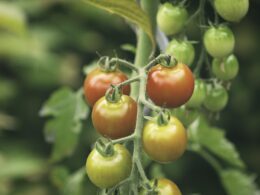If you’ve ever grown tomatoes, you know how important it is to keep your plants healthy and strong. One way to do this is by providing them with the essential nutrients they need, such as calcium. Calcium plays a crucial role in cell division and strengthening cell walls, which ultimately leads to healthier and more resilient plants.
But did you know that eggshells can be an excellent source of calcium for your tomato plants? In fact, adding eggshells to your tomato plants can help prevent common issues like blossom-end rot, ensuring a bountiful harvest.
In this article, we’ll dive into the benefits of using eggshells for your tomato plants and discuss how often you should add them. We’ll also cover the best methods for preparing and applying eggshells to ensure maximum benefit for your precious tomatoes. Plus, we’ll explore other natural sources of calcium that can support the health and vitality of these tasty garden gems.
So let’s get started on making sure our tomato plants are not only safe but thriving!
Benefits of Eggshells for Tomato Plants
There’s no doubt that using eggshells can work wonders for your tomato plants. They offer numerous benefits to help them thrive. Eggshells are a natural source of calcium, an essential nutrient for strong cell walls and overall plant health. When you add crushed eggshells to the soil around your tomato plants, you’re providing them with a steady supply of calcium that will keep them growing strong and healthy.
In addition to supporting robust growth, adding eggshells can also help prevent common tomato problems like blossom end rot. This condition occurs when there’s not enough calcium available in the soil, causing the fruit to develop dark, sunken spots on the bottom. By incorporating crushed eggshells into your planting mix or sprinkling them around established plants, you’ll ensure your tomatoes have access to all the calcium they need to grow without any issues.
Another benefit of using eggshells in your garden is that they deter pests like slugs and snails from munching on your precious crops. The sharp edges of crushed shells create an uncomfortable surface for these slimy creatures to crawl over, encouraging them to look elsewhere for their next meal.
So, while you’re nourishing your tomatoes with vital nutrients and preventing common problems like blossom end rot, you’re also creating a safer environment where they can flourish without being attacked by pesky pests.
Preparing Eggshells for Use
Before using them in your garden, make sure to properly prepare those eggshells for the best results. Preparing eggshells is a simple process that can be done in just a few steps. This helps ensure that you’re providing your tomato plants with the nutrients they need while keeping unwanted pests at bay.
Here’s how to prepare your eggshells:
- Rinse the shells thoroughly to remove any residual yolk or white.
- Allow the shells to dry completely on a towel or paper towel.
- Crush the dried shells into small, fine pieces using a mortar and pestle, a rolling pin, or even by placing them inside a plastic bag and crushing them with your hands.
- Store the crushed shells in an airtight container until you’re ready to use them around your tomato plants.
By taking these precautions when preparing eggshells for use in your garden, you can feel confident that you’re giving your tomato plants the best chance at thriving while ensuring their safety from potential harm caused by improper preparation techniques. So go ahead and give those little red beauties some calcium-rich love – they’ll thank you for it with vigorous growth and delicious fruit!
Best Methods for Adding Eggshells to Tomato Plants
Now that you’ve got your eggshells prepped, let’s dive into the most effective ways to incorporate them into your tomato garden for optimal growth and flavor.
The first method is to add crushed eggshells directly to the planting hole when transplanting your tomato seedlings. This allows the calcium from the shells to be readily available as soon as the roots start growing, preventing issues like blossom end rot and encouraging strong root development. To do this, simply place a handful of crushed eggshells in each planting hole before placing your seedling inside.
Another great way to use eggshells in your tomato garden is by creating an eggshell tea. This may sound peculiar, but it’s actually an excellent method for providing a slow-release source of calcium throughout the growing season. To make eggshell tea, all you need to do is steep one cup of crushed eggshells in one gallon of water for 24 hours or more. Then, strain out the shells and use this nutrient-rich solution to water your plants once every two weeks. Your tomatoes will love this little extra boost!
Lastly, you can simply sprinkle crushed eggshells around the base of your tomato plants during their growth period. This method helps deter pests like slugs and snails while also slowly releasing calcium into the soil as they break down over time. It’s best practice to reapply a fresh layer of crushed shells every few weeks throughout the growing season so that there’s always some available for both pest prevention and nutrient supplementation purposes!
Happy gardening!
Determining the Frequency of Adding Eggshells
It’s time to figure out how frequently those eggshells need to make an appearance in your tomato garden!
Determining the right frequency for adding eggshells to your tomato plants can help ensure they get the calcium boost they need without overloading the soil. Generally, you should add crushed eggshells once at the beginning of the planting season and then again when you see signs of calcium deficiency or as a preventive measure every 4-6 weeks.
Pay close attention to your tomato plants’ growth and overall health. If you start noticing symptoms like blossom end rot, stunted growth, or yellowing leaves, it could be a sign that they’re lacking calcium. In this case, don’t hesitate to give them another dose of crushed eggshells sooner than initially planned.
Remember that moderation is key; too much calcium could lead to an imbalance in other nutrients needed by your plants.
By keeping a consistent schedule for adding crushed eggshells to your tomato plants, you’ll provide them with a steady source of calcium while avoiding potential nutrient imbalances. This not only keeps your plants happy but also ensures that you’ll have a bountiful harvest of delicious tomatoes throughout the season.
So keep an eye on those tomatoes and let their needs guide you in determining the perfect frequency for giving them their nutritious eggshell treat!
Other Natural Sources of Calcium for Tomato Plants
Looking for more ways to provide calcium to your tomatoes? Let’s explore other natural sources that can do the trick! There are various options available, ensuring that your tomato plants receive adequate amounts of calcium throughout their growth.
Not only will these alternatives help prevent issues such as blossom end rot, but they also contribute to healthier and stronger plants overall. So, experiment with these options and find which one works best for your garden’s specific needs by testing your soil’s pH level and considering factors like availability and cost-effectiveness.
Here are some options to consider:
-
Bone meal: Rich in both calcium and phosphorus, bone meal is an excellent option for providing nutrients to your tomato plants. Simply mix it into the soil before planting or sprinkle it around the base of established plants.
-
Gypsum: Adding gypsum (calcium sulfate) directly to the soil can improve its structure while increasing calcium levels without raising the pH. This makes it a great choice if you have acidic soil.
-
Lime: If your soil is too acidic, adding lime (calcium carbonate) can help balance its pH while simultaneously supplying calcium to your tomatoes. Be cautious when using lime, as excessive amounts can lead to overly alkaline soils.
-
Crushed oyster shells: Similar to eggshells, crushed oyster shells break down slowly over time and release calcium into the soil.
Remember that consistency in providing proper nutrients will result in healthy tomato plants producing delicious fruits all season long! So keep an eye on those tomatoes and give them all the love they need – they’ll thank you with a bountiful harvest!
Conclusion
In conclusion, incorporating eggshells into your tomato plants’ care routine is a fantastic way to boost their calcium levels, promoting healthier growth. Just remember to clean and crush the shells before adding them to the soil or compost.
Don’t stress about the exact frequency – simply add eggshells as you have them available. Feel free to explore other natural sources of calcium too, ensuring your tomatoes thrive!









